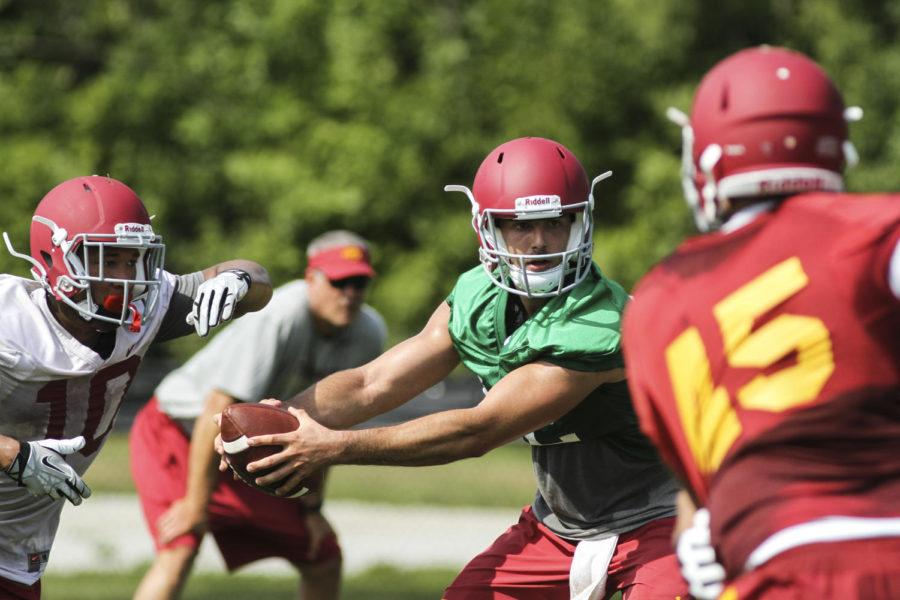Tipping the scale: Autonomy gives universities more leeway to provide for student-athletes
August 25, 2014
On Aug. 7, the NCAA granted autonomy to the Power 5 conferences. In one day, the most prominent governing body in collegiate athletics ceded more control to its member universities than it had collectively during the course of its entire 108-year existence.
The transfer of power
As the NCAA’s grip on collegiate athletics weakens, it is the 65 schools in the five major conferences which rise up to fill the power vacuum.
“The NCAA has granted the five high visibility conferences [the Big 12, Big 10, Pac 12, SEC and ACC] … autonomy to come up with legislation in designated areas,” said ISU senior associate athletic director David Harris.
Autonomy essentially means self-governance. To put it in the simplest terms, the wealthiest institutions now have more freedom to put that wealth to use and separate themselves as destinations for the country’s most dynamic high school athletes. This is achieved by improving the offers that can be made to players.
Potential improvements to student-athlete provisions
What improvements will come is yet to be determined, but Harris said that the mandate from conference commissioners is that, for now, all changes are to be focused on improving student-athlete well-being.
“At this point, the conferences want to come together and figure out what things we would like to do. What are the things we think are important,” Harris said. “[Iowa State] has already done some things with the unlimited meal legislation to try and make sure that we improve the services we provide in that area for student-athletes.”
The unlimited meal plan was not regulated under the previous rule system, which is why Iowa State was able to enact it before the new NCAA legislation becomes official.
Harris said if and when autonomy is officially granted, there are numerous possibilities for improvements on top of the alterations to the meal plan that Iowa State has already made on its own.
The headliners are covering the full cost of attendance via scholarships — Iowa State currently offers an amount roughly $4,400 short of full cost — as well as providing health insurance coverage to players after graduation.
Harris said that technological needs and paying for parents to attend official visits as well as postseason games are also issues that have already gained momentum.
Remaining obstacles
The new legislation is not yet a done deal, however, as an override period exists until Oct. 6. During that time, every NCAA member institution has an opportunity to cast an override veto. If 75 schools cast an override veto, the matter will return to the table for further consideration.
ISU associate athletic director and compliance program manager Dustin Gray said that as of Aug. 21, only one university had cast such a veto.
Harris said that in the past, proposals which would cede power to all universities to make improvements for student-athletes were shot down by smaller institutions that did not want to see the richer schools gain more opportunity to lean on their financial advantages.
How the new system will work
Under the new system, every school would have the same right to enhance the packages it offers to potential student-athletes but not necessarily the same opportunity.
“Basically, it would be a vote of the autonomous five [to enact a new rule] and if it passes, the entire NCAA membership could apply the legislation,” Gray said. “But how that trickles down is dependent on how schools want to do it.”
The fear is that this new system will widen the already large gap between schools in the Power 5 conferences and the rest of the country, but Harris said that there is more to it than even that.
“A competitive imbalance already exists,” Harris said. “Even within those 65 schools you will see institutions that are in a much better financial position than others. There may be things that are ultimately voted in that all the schools can enact, but won’t all choose to [enact].”
Why now?
Harris said the crux of the issue as he sees it is the improvement of conditions for student-athletes, but there are differing opinions.
Media upheaval about the treatment and compensation of student-athletes has grown more fervent in recent months, putting increased pressure on the NCAA to make changes as Northwestern players mobilize toward potential unionization for private universities.
A U.S. district court also recently ruled against the NCAA in an antitrust lawsuit brought by former UCLA basketball player Ed O’Bannon concerning the use of player names and likenesses for profit.
However, SEC Commissioner Mike Silve also made a statement in July that if the meeting from which this new legislation was born did not produce a satisfactory outcome on these issues, his conference would have to consider a venue separate from the NCAA to provide for its student-athletes the way it wanted to.
Whether the added pressure of the events at Northwestern and the court ruling against the NCAA played a role in spurring it to reevaluate its position on student-athlete provisions — or the threat of losing the revenue generated by the nation’s top conferences did — the situation for student-athletes across the country is likely about to become more lucrative.
Harris said changes could come as early as later this year or at the beginning of the 2015 school year.







